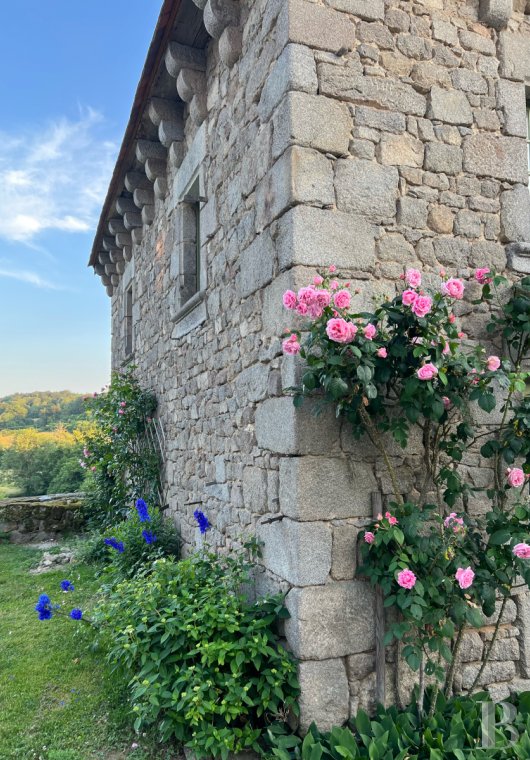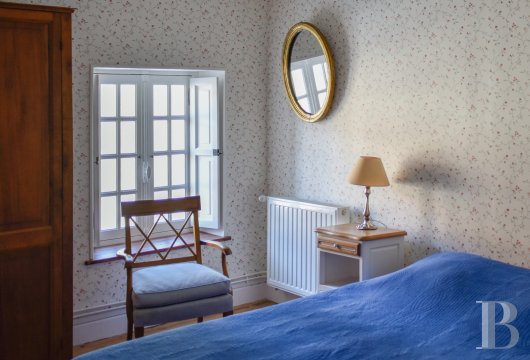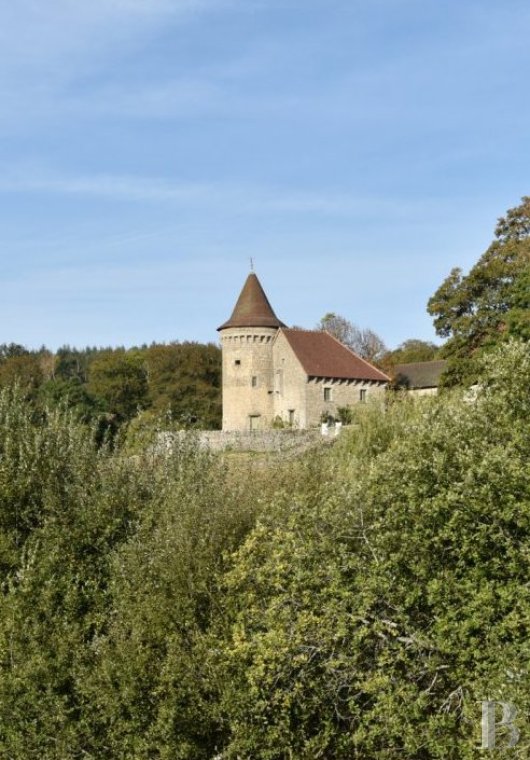Add to favorites
Log in to your personal space

The first thing you see when you are driving down the narrow road that winds its way through the bocage of the Creuse region, is the turret’s dominating roof. The château is surrounded by majestic trees, while the porch and defensive walls bring the Middle Ages to life. The inner courtyard opens out onto the rolling countryside, and the stone guest house, with its flat-tiled roof and round tower, takes visitors back in time. The small-paned windows herald the warmth and com-fort of the recently renovated interior, which includes terracotta floor tiles, a granite fireplace for roaring fires, deep sofas and armchairs, a vast stone-tiled shower room, new antique wallpaper in the bedrooms, and family furniture and paintings. This guest house will make visitors feel special. They will instantly feel at home, and enjoy the now rare experience of a natural environment where people keep a low profile, leaving plenty of room for silence, the harmony of the seasons and the passage of wild animals.
We came to the Creuse by chance. We had been looking for a property to settle down in for some time. We had very specific criteria, including: architectural quality, enough space to accommodate children and friends but without being too large, a building in good condition but with the possibility of redecorating according to our taste, several dwellings, outbuildings, undulating countryside and above all silence. We had a number of unsuccessful visits, first in Burgundy and then in Lot and Dordogne. Upon visiting this property, however, it became clear to us that it met all of our criteria, and without us having to make any concessions, which is rare. We didn't hesitate for a second from our very first visit.

It is a stronghold that has been altered several times over the centuries. The dungeon dates from the 13th century, and the main dwelling from the 16th and 17th centuries, as does the second dwelling with its round tower, and the outbuildings. The defensive walls have been partly preserved, although they have been extensively redesigned to open up the views over the surrounding countryside. A number of defensive features have been preserved, such as the entrance porch topped with machicolations, the dungeon’s covered walkway, the loopholes and archways in the round tower of the second dwelling, and the two brattices that are in perfect condition. The out-buildings’ stables feature period paving, traces of an old bread oven and a vast oblong monolithic basin carved out of granite, whose purpose we are unsure of. The houses have the advantage of having been renovated in the early 20th century, making them perfectly liveable by modern standards. There are even windows in the turret, making it less austere.
The former owners left us a whole box of handwritten archives that they had patiently collected. Written mostly in Old French, they are often difficult to decipher, but we can trace most of the families who lived here from the 15th century to the Revolution. We even have an invoice for the construction of one of the buildings in the very early 17th century by local stonemasons! There are still a few gaps in the lineage of the owners up to the very early 20th century. The site was clearly self-sufficient with several wells, stables, and cowsheds. The agricultural and forestry estate was much larger than it is today. It must have originally formed part of a line of defence that controlled the border between this region of the Haute-Marche and the nearby Auvergne.

The stronghold architecture is what makes this place unique. The 17th-century dwelling we rent out has been completely renovated in the style of a country house. It can accommodate five or six people. We have preserved a number of reminders of the past, such as the loopholes (including in the shower!) and the two brattices. Above all, it is the silence that stands out to our guests. The only sounds you will hear are the murmur of the river that crosses the property below or birds singing, especially in the spring. We're right in the middle of nature, at an altitude of 650 metres, in a seven-hectare park enclosed by walls. We are surrounded by woods and natural pastures where Limousin and Charolais cattle graze. For astronomy enthusiasts, the absence of light pollution means that the skies are completely clear, making the Milky Way perfectly visible. On full moon nights, the light on the surrounding landscape and the courtyard is truly spectacular. The Creuse, a department that is often overlooked and sometimes even disparaged, is in fact a treasure trove for all nature lovers. There are plenty of opportunities for hiking, particularly on the Millevaches plateau. Here, the sunken paths have been preserved, bordered by miles of hedgerows and low stone walls. Even on the hottest days, the nights remain cool, with sometimes spectacular temperature differences of over 20 degrees. Our guest house is therefore a gateway to a rural area that has not been denatured, with a multitude of things to do, including visits to historic monuments and museums, excursions, white-water fishing and swimming in beautiful lakes.
There are various things to do! For lovers of history and architecture, we particularly recommend the nearby towers of the ancient fortress of Crocq, which offer a magnificent view of the Limousin on one side and the Auvergne on the other. The château de Villemonteix in Saint-Pardoux-les-Cards has a fine collection of tapestries and the château d'Étangsannes in Saint-Chabrais features the work of 16th-century Italian artists. The Banizette estate in La Nouaille offers an insight into rural life in the 19th century, with its collection of tools and domestic objects, not to mention a beautiful garden and arboretum. A little further afield is the Château de Boussac in the north of the département, where George Sand discovered the famous Lady and the Unicorn tapestries, now on display at the Musée de Cluny in Paris. Of course, you can't miss the Cité Internationale de la Tapisserie in Aubusson, which traces the centuries-old history of this craft, recognised by UNESCO as part of humanity's intangible cultural heritage. Our favourite village in the area is un-doubtedly Felletin, another tapestry centre. The 12th-century church, remodelled in the 15th cen-tury, has been completely restored in accordance with the rules of art, highlighting in particular its frescoes. There is also a very popular weekly market in the centre of the town on Friday mornings, with many local and Auvergne producers. The Aubusson market, held along the Creuse on Satur-day mornings, is also very charming. For lovers of fine dining, our favourite restaurants are con-centrated in Aubusson. "La Rizière" offers top-class Asian cuisine prepared fresh by the owner. "La Terrade", set on the riverbank with a terrace overlooking the water, offers traditional yet sophisticated cuisine. We also like "Le Colbert", a hotel-restaurant housed in an 18th-century town house in the town centre. As for walks, there are too many to name here, but we'll be happy to point them out to our guests!

The entire property - the exterior, the guest house, and the outbuildings - is available for filming or photography, with the exception of the château, which may be available depending on the project, on a case-by-case basis.
ref 935603

 A link to enter a new password has been sent to you by email.
A link to enter a new password has been sent to you by email.
By continuing your navigation, you accept the use of cookies to offer you services and offers adapted to your centers of interest and to measure the frequentation of our services. Learn more